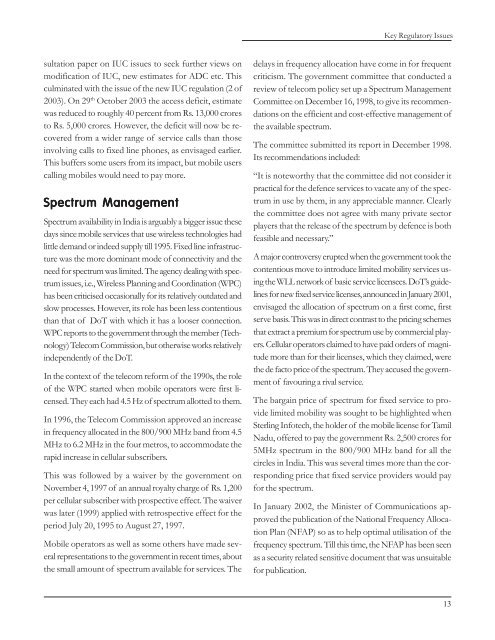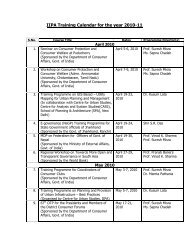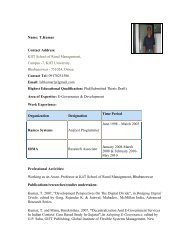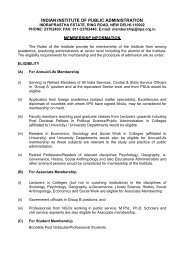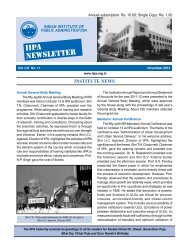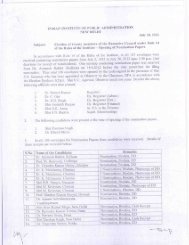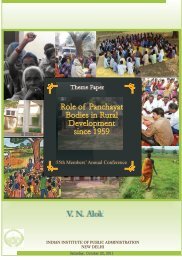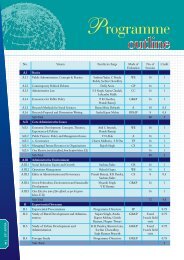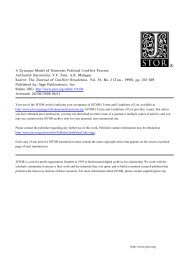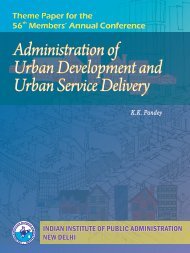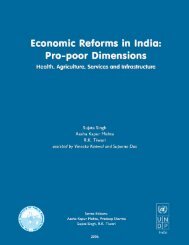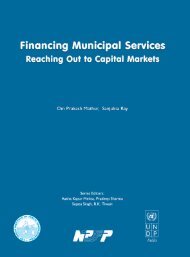India's Telecom Reform - Indian Institute of Public Administration
India's Telecom Reform - Indian Institute of Public Administration
India's Telecom Reform - Indian Institute of Public Administration
Create successful ePaper yourself
Turn your PDF publications into a flip-book with our unique Google optimized e-Paper software.
Key Regulatory Issues<br />
sultation paper on IUC issues to seek further views on<br />
modification <strong>of</strong> IUC, new estimates for ADC etc. This<br />
culminated with the issue <strong>of</strong> the new IUC regulation (2 <strong>of</strong><br />
2003). On 29 th October 2003 the access deficit, estimate<br />
was reduced to roughly 40 percent from Rs. 13,000 crores<br />
to Rs. 5,000 crores. However, the deficit will now be recovered<br />
from a wider range <strong>of</strong> service calls than those<br />
involving calls to fixed line phones, as envisaged earlier.<br />
This buffers some users from its impact, but mobile users<br />
calling mobiles would need to pay more.<br />
Spectrum Management<br />
Spectrum availability in India is arguably a bigger issue these<br />
days since mobile services that use wireless technologies had<br />
little demand or indeed supply till 1995. Fixed line infrastructure<br />
was the more dominant mode <strong>of</strong> connectivity and the<br />
need for spectrum was limited. The agency dealing with spectrum<br />
issues, i.e., Wireless Planning and Coordination (WPC)<br />
has been criticised occasionally for its relatively outdated and<br />
slow processes. However, its role has been less contentious<br />
than that <strong>of</strong> DoT with which it has a looser connection.<br />
WPC reports to the government through the member (Technology)<br />
<strong>Telecom</strong> Commission, but otherwise works relatively<br />
independently <strong>of</strong> the DoT.<br />
In the context <strong>of</strong> the telecom reform <strong>of</strong> the 1990s, the role<br />
<strong>of</strong> the WPC started when mobile operators were first licensed.<br />
They each had 4.5 Hz <strong>of</strong> spectrum allotted to them.<br />
In 1996, the <strong>Telecom</strong> Commission approved an increase<br />
in frequency allocated in the 800/900 MHz band from 4.5<br />
MHz to 6.2 MHz in the four metros, to accommodate the<br />
rapid increase in cellular subscribers.<br />
This was followed by a waiver by the government on<br />
November 4, 1997 <strong>of</strong> an annual royalty charge <strong>of</strong> Rs. 1,200<br />
per cellular subscriber with prospective effect. The waiver<br />
was later (1999) applied with retrospective effect for the<br />
period July 20, 1995 to August 27, 1997.<br />
Mobile operators as well as some others have made several<br />
representations to the government in recent times, about<br />
the small amount <strong>of</strong> spectrum available for services. The<br />
delays in frequency allocation have come in for frequent<br />
criticism. The government committee that conducted a<br />
review <strong>of</strong> telecom policy set up a Spectrum Management<br />
Committee on December 16, 1998, to give its recommendations<br />
on the efficient and cost-effective management <strong>of</strong><br />
the available spectrum.<br />
The committee submitted its report in December 1998.<br />
Its recommendations included:<br />
“It is noteworthy that the committee did not consider it<br />
practical for the defence services to vacate any <strong>of</strong> the spectrum<br />
in use by them, in any appreciable manner. Clearly<br />
the committee does not agree with many private sector<br />
players that the release <strong>of</strong> the spectrum by defence is both<br />
feasible and necessary.”<br />
A major controversy erupted when the government took the<br />
contentious move to introduce limited mobility services using<br />
the WLL network <strong>of</strong> basic service licensees. DoT’s guidelines<br />
for new fixed service licenses, announced in January 2001,<br />
envisaged the allocation <strong>of</strong> spectrum on a first come, first<br />
serve basis. This was in direct contrast to the pricing schemes<br />
that extract a premium for spectrum use by commercial players.<br />
Cellular operators claimed to have paid orders <strong>of</strong> magnitude<br />
more than for their licenses, which they claimed, were<br />
the de facto price <strong>of</strong> the spectrum. They accused the government<br />
<strong>of</strong> favouring a rival service.<br />
The bargain price <strong>of</strong> spectrum for fixed service to provide<br />
limited mobility was sought to be highlighted when<br />
Sterling Infotech, the holder <strong>of</strong> the mobile license for Tamil<br />
Nadu, <strong>of</strong>fered to pay the government Rs. 2,500 crores for<br />
5MHz spectrum in the 800/900 MHz band for all the<br />
circles in India. This was several times more than the corresponding<br />
price that fixed service providers would pay<br />
for the spectrum.<br />
In January 2002, the Minister <strong>of</strong> Communications approved<br />
the publication <strong>of</strong> the National Frequency Allocation<br />
Plan (NFAP) so as to help optimal utilisation <strong>of</strong> the<br />
frequency spectrum. Till this time, the NFAP has been seen<br />
as a security related sensitive document that was unsuitable<br />
for publication.<br />
13


